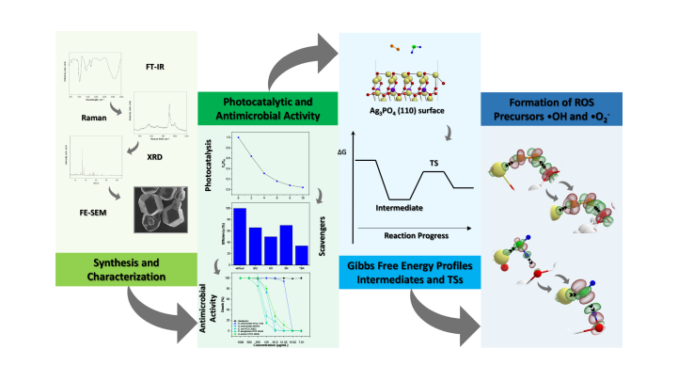

Atomistic computer simulations based on density functional theory have led to the identification of a previously unknown mechanism for the formation of reactive oxygen species (image: CDMF)
Experiment with the semiconductor silver phosphate revealed an unprecedented mechanism for the formation of reactive oxygen species – toxic molecules that can cause the death of pathogens.
Experiment with the semiconductor silver phosphate revealed an unprecedented mechanism for the formation of reactive oxygen species – toxic molecules that can cause the death of pathogens.

Atomistic computer simulations based on density functional theory have led to the identification of a previously unknown mechanism for the formation of reactive oxygen species (image: CDMF)
Agência FAPESP* – A theoretical-experimental study involving researchers from the Center for the Development of Functional Materials (CDMF) has reached unprecedented conclusions about the biocidal activity of the semiconductor silver phosphate. The work, described in an article published in The Journal of Physical Chemistry C, shows that this activity is associated with the formation of reactive oxygen species (ROS). These highly unstable molecules are capable of generating oxidative stress and causing the death of pathogens.
The CDMF is a FAPESP Research, Innovation and Dissemination Center (RIDC) based at the Federal University of São Carlos (UFSCar).
In the study, atomistic computer simulations based on density functional theory (DFT) led to the identification of a previously unknown mechanism for the formation of ROS. This mechanism involves the cooperative activation of a water molecule and an oxygen molecule on the surface of silver phosphate.
DFT is one of the main theories of quantum mechanics. It has been used to describe electronic properties in solid-state physics, quantum chemistry, materials science, biochemistry, biology, nanosystems, and atomic-scale systems.
The researchers found that the surface of the semiconductor acts as a catalyst, facilitating the transfer of electrons from the water molecule to the surface and from there to the oxygen molecule. This process leads to the formation of the precursor species of ROS: hydroxyl and superoxide.
Miguel San-Miguel, a researcher associated with the CDMF and one of the authors of the article, explained that the results open up innovative perspectives for understanding the formation of ROS in materials based on silver semiconductors. He also explained that they make it possible to explore the mechanism identified in other materials, which favors research into low-cost biocidal applications. “This advance not only improves theoretical knowledge on the subject but also offers potential practical implications for the effective use of these materials in biological contexts,” he states.
The study involved researchers from UFSCar, the State University of Campinas (UNICAMP), Jaume I University and the University of Valencia, both in Spain, and the Federal University of Santa Catarina (UFSC).
The article “A Tale of Reactive Oxygen Species on the Ag3PO4(110) Surface” can be read at: pubs.acs.org/doi/10.1021/acs.jpcc.3c06321.
* With information from the CDMF.
Republish
The Agency FAPESP licenses news via Creative Commons (CC-BY-NC-ND) so that they can be republished free of charge and in a simple way by other digital or printed vehicles. Agência FAPESP must be credited as the source of the content being republished and the name of the reporter (if any) must be attributed. Using the HMTL button below allows compliance with these rules, detailed in Digital Republishing Policy FAPESP.





